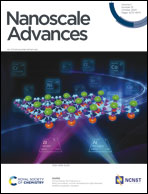High-purity reflective color filters based on thin film cavities embedded with an ultrathin Ge2Sb2Te5 absorption layer†
Abstract
A thin film cavity formed by stacking metal–insulator–metal (MIM) continuous layers is of significant interest as a lithography-free and scalable color-filtering structure. Such a cavity can selectively transmit a certain frequency range of incident light, thus producing vivid transmission colors. However, the generation of reflection colors with high purity and reflectivity is a challenge because a cavity in reflection mode resonantly absorbs a narrow range of wavelengths and reflects the remaining spectrum. This study shows that highly pure and reflective colors can be obtained by embedding an ultrathin Ge2Sb2Te5 layer within the cavity. Because the MIM structure exhibits a nonuniform intensity distribution across the insulator layer, the approach is to place the Ge2Sb2Te5 layer in a high-intensity region within the insulator and thereby create another absorption band in addition to the cavity resonance mode. When combined with the refractive-index engineering of the metal layer, this approach leads to red, green, and blue colors having a bandwidth of ∼100 nm and a reflection efficiency of 90%. The results of the study may be effectively utilized in numerous applications, including reflective color filters, colorimetric sensors, and surface decorations.



 Please wait while we load your content...
Please wait while we load your content...